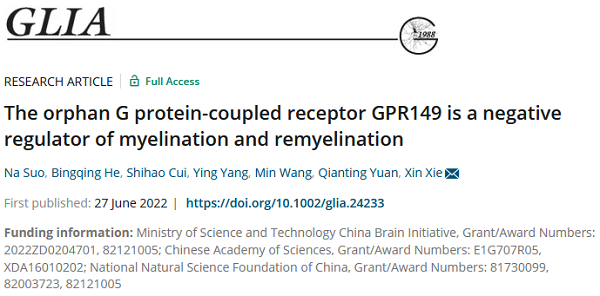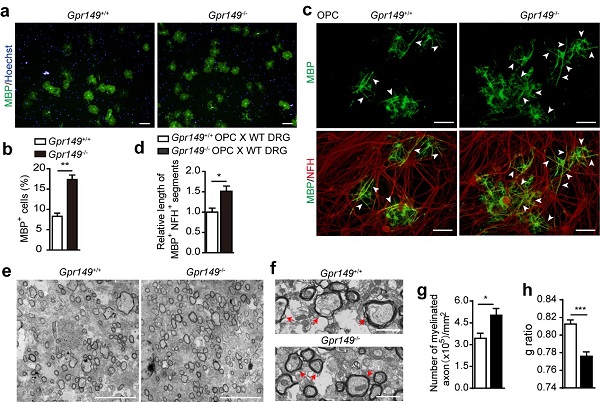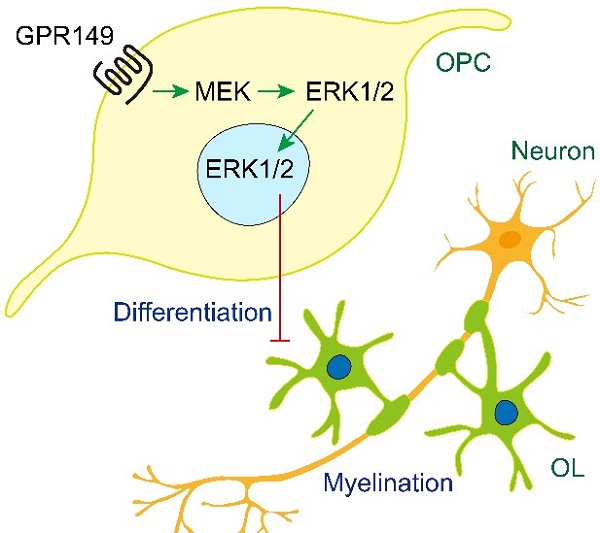Scientists Discover Orphan Receptor GPR149 Negatively Regulates Myelination and Remyelination
Myelin is a lipid-rich multi-lamellar membrane on nerve fibers. More than an insulator, myelin sheath changes the way the neural impulses are transmitted and speeds the nerve conduction velocity. In addition, myelin sheath provides essential metabolic support for axon function. Destruction of myelin in the central nervous system would lead to delayed nerve conduction velocity, axonal degeneration and neurological disabilities associated with disorders such as Multiple Sclerosis (MS) and leukodystrophies. Therefore, discovering the mechanism of myelin development and remyelination after myelin damage is of great clinical interest, and is the key to identify drug targets for remyelination therapy.
Recently, in a study published in Glia, a group of scientists led by XIE Xing from the Shanghai Institute of Materia Medica, Chinese Academy of Sciences, has reported the function of GPR149 in oligodendrocytes differentiation and myelin formation for the first time.

Oligodendrocytes (OLs), differentiated from oligodendrocyte precursor cells (OPCs), are important for myelination during development and myelin repair in CNS demyelinating disease. The researchers initially found that GPR149 was highly expressed in OPCs, but was downregulated when OPCs differentiated into mature OLs, indicating a potential role or GPR149 in this process.
It remains to be found about the ligand, signal transduction and physiological functions of GPR149, an orphan G protein-coupled receptor (GPCR). So the researchers generated GPR149 knockout (KO) mice. They found that the myelin development was enhanced in GPR149 KO mice. GPR KO did not seem to affect the proliferation of OPCs, but rather promoted the differentiation of OPCs into OLs. In cuprizone-induced demyelination model, GPR149 deficiency significantly enhanced myelin regeneration. Further study indicated that GPR149 may regulate oligodendrocyte differentiation and myelin formation via MAPK/ERK pathway. The study suggested that deleting or blocking GPR149 might be an intriguing way to promote myelin repair in demyelinating diseases.

Fig.1. (a, b) GPR149 KO promotes OPC to OL differentiation in vitro; (c, d) GPR149 KO enhances myelin formation in OPC-DRG neuron co-culture system;(e-h) GPR149 KO promotes myelin regeneration in Cuprizone-induced demyelination mice.
Prof. Xie’s group has been studying the mechanisms involved in OPC to OL differentiation, and has discovered that Kappa opioid receptor (KOR) is critically involved in OL generation and remyelination (Nature Communications, 2016;7:13594), and that a number of small molecules including vitamin C, MAPK inhibitors and donepezil (an AD drug), can regulate OPC to OL differentiation and promote myelin repair (Glia, 2019;67(7):1320-1332; Glia, 2018;66:1302–1316; APS, 2019;40(11):1386-1393).

Fig.2. GPR149 negatively regulates OPC to OL differentiation and myelin formation, possibly by regulating the MAPK/ERK pathway.
Link to the paper:https://onlinelibrary.wiley.com/doi/10.1002/glia.24233




